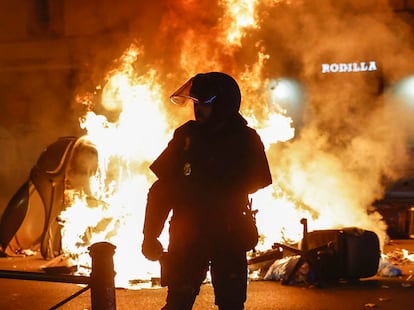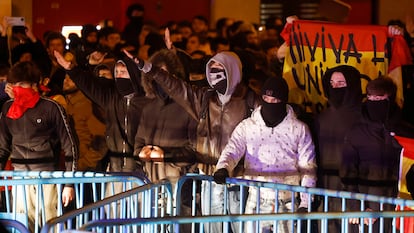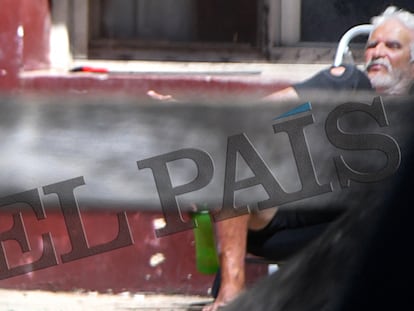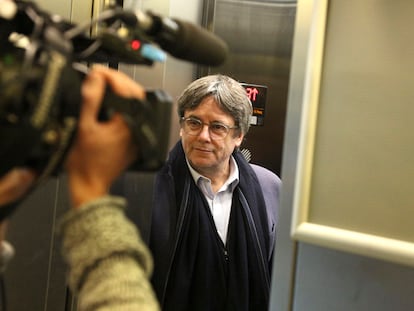Inside the violence behind Spain’s anti-amnesty demonstrations
Many youths, who previously used sporting events to vent their anger, are using recent protests against the Socialist government of Pedro Sánchez to regain lost visibility, according to the police

Dozens of young people gathered on Tuesday afternoon in the basement of a bar located near Ferraz Street in Madrid. This street is home to the headquarters of the Spanish Socialist Party (PSOE) and in recent days it has been the site of numerous protests against the deal reached between Spain’s caretaker government and Catalan separatists, which grants amnesty to people involved in the 2017 illegal breakaway attempt in exchange for political support, paving the way for Prime Minister Pedro Sánchez to remain in power following an inconclusive election in July.
Almost all the youths at the bar are men between 20 and 30 years of age. They are all wearing similar clothing: sports shoes, tight sweatpants or jeans, sweatshirts and black winter coats with hoods, many of them made by The North Face. Many of them are also wearing scarves or neck gaiters that allow them to partially cover their faces. They have been drinking beer since early in the afternoon, while people gather outside with banners, symbols and flags of Spain in different formats. In between drinks, they cheer one another with patriotic shouts and negative comments about the Socialist prime minister: “No, it can’t be, bro! We have a PM who has put the government in the hands of those who want to break up Spain! Those sons of bitches!” Everyone has their cellphone out and is following an ongoing protest being livestreamed on Instagram. They are waiting for a call that finally arrives two hours later, around 10:00 p.m.

“Now! Let’s go get them!” In a matter of seconds, bottles in hand, the crowd vacates the bar, whose two floors they had taken over. Outside, the youths start throwing the objects they were carrying in their hands at the riot police. They grab chairs from the restaurants and bars that they find in their path and send them flying in the air. They are working in rows, moving from front to back, retreating from police pressure and taking shelter in nearby premises if necessary. None of the six people arrested on Tuesday night had a police record or has been linked to these violent groups, according to police sources.
“This is typical behavior by the ultras of the Frente Atlético and Ultra Sur [hooligan groups that follow the soccer teams Atlético de Madrid and Real Madrid]. They congregate in their bar-headquarters, they drink their asses off and then, when things are hot enough, they receive an alert and go out to mess it up and unleash all their violence, because that is their only objective, the fun of releasing their aggression,” notes an officer from the Information Services of the National Police, who has been monitoring these groups for years. “And since now they cannot do it in the stadiums, they do it here, in Ferraz Street, for example, or wherever they are summoned.” The methodology was repeated again on Thursday night at the same location on Ferraz Street.
Police experts have recognized members of these groups on the fringes of the demonstrations at PSOE headquarters in Madrid. There were also members of a few far-right groups that were nearly extinct or short-lived and opportunistic, such as Falange, National Democracy, Frontal Bastion, Social Home, Making a Nation, Desokupa, Solidarity and Revolt... “In reality they are few, and by themselves they have no strength to accomplish anything. That is why they use these events to regain some visibility,” explain these sources.
Ever since Francisco Javier Romero Taboada, alias Jimmy, a member of the hooligan group Riazor Blues, was allegedly beaten to death by members of the Atlético Front in 2014, these violent fans have been banned from soccer stadiums and lost a good deal of the VIP treatment that they had enjoyed, becoming mush less visible, dispersed and relegated to the background.

On Tuesday, not all the violent protesters were refueling at the bar. Others with identical appearance could be seen drinking and smoking in the streets adjacent to the protest, inside cars parked in the streets, or outside convenience stores run by Chinese citizens where they bought their beer: “Go put more greens [beers] in the refrigerator!” they shouted at the owner of one business, while discussing whether one of them had brought brass knuckles.
For much of the night, while thousands chanted against Pedro Sánchez, against “Muslim Spain” and the “manipulative Spanish press,” or raised their hands to sing Cara al Sol (a fascist anthem) in front of PSOE headquarters, they waited in the rear, biding their time. However, their degree of organization is a far cry from the urban guerrilla tactics of coordinated violent groups on display in Catalonia following the conviction of Catalan secessionist leaders in October 2019 or the imprisonment of rapper Pablo Hasél in 2021, when professionalized vandalism seemed to take over the streets of the main Catalan capitals.
About two miles from Ferraz, two of the main promoters of the protests — the YouTuber Alvise Pérez and Daniel Esteve, head of Desokupa, a company specializing in evicting squatters — announced to their followers (on Instagram they have 640,0000 and 336,000 each) that they were going “out to dinner.” As tension grew in Ferraz, they wanted to make it clear that they were not encouraging violence. After all, in the case of Esteve and dozens of other anti-squatter companies, they usually notify the riot police and the National Police when an eviction turns violent, according to reports.
“This has been like a rite of passage. It creates a type of cohesion. Because if something happens to you and something happens to me, that unites us, man,” said two of the rioters, as they rode the subway back home. But with a new demonstration against the amnesty planned for this coming Sunday, this time sponsored by the mainstream conservative Popular Party, many politicians (and non-politicians) who justified and attended the recent rallies are now seeking to disassociate themselves from the violence.
Sign up for our weekly newsletter to get more English-language news coverage from EL PAÍS USA Edition
Tu suscripción se está usando en otro dispositivo
¿Quieres añadir otro usuario a tu suscripción?
Si continúas leyendo en este dispositivo, no se podrá leer en el otro.
FlechaTu suscripción se está usando en otro dispositivo y solo puedes acceder a EL PAÍS desde un dispositivo a la vez.
Si quieres compartir tu cuenta, cambia tu suscripción a la modalidad Premium, así podrás añadir otro usuario. Cada uno accederá con su propia cuenta de email, lo que os permitirá personalizar vuestra experiencia en EL PAÍS.
¿Tienes una suscripción de empresa? Accede aquí para contratar más cuentas.
En el caso de no saber quién está usando tu cuenta, te recomendamos cambiar tu contraseña aquí.
Si decides continuar compartiendo tu cuenta, este mensaje se mostrará en tu dispositivo y en el de la otra persona que está usando tu cuenta de forma indefinida, afectando a tu experiencia de lectura. Puedes consultar aquí los términos y condiciones de la suscripción digital.
More information
Archived In
Últimas noticias
Most viewed
- Sinaloa Cartel war is taking its toll on Los Chapitos
- Reinhard Genzel, Nobel laureate in physics: ‘One-minute videos will never give you the truth’
- Oona Chaplin: ‘I told James Cameron that I was living in a treehouse and starting a permaculture project with a friend’
- Why the price of coffee has skyrocketed: from Brazilian plantations to specialty coffee houses
- David King, chemist: ‘There are scientists studying how to cool the planet; nobody should stop these experiments from happening’










































